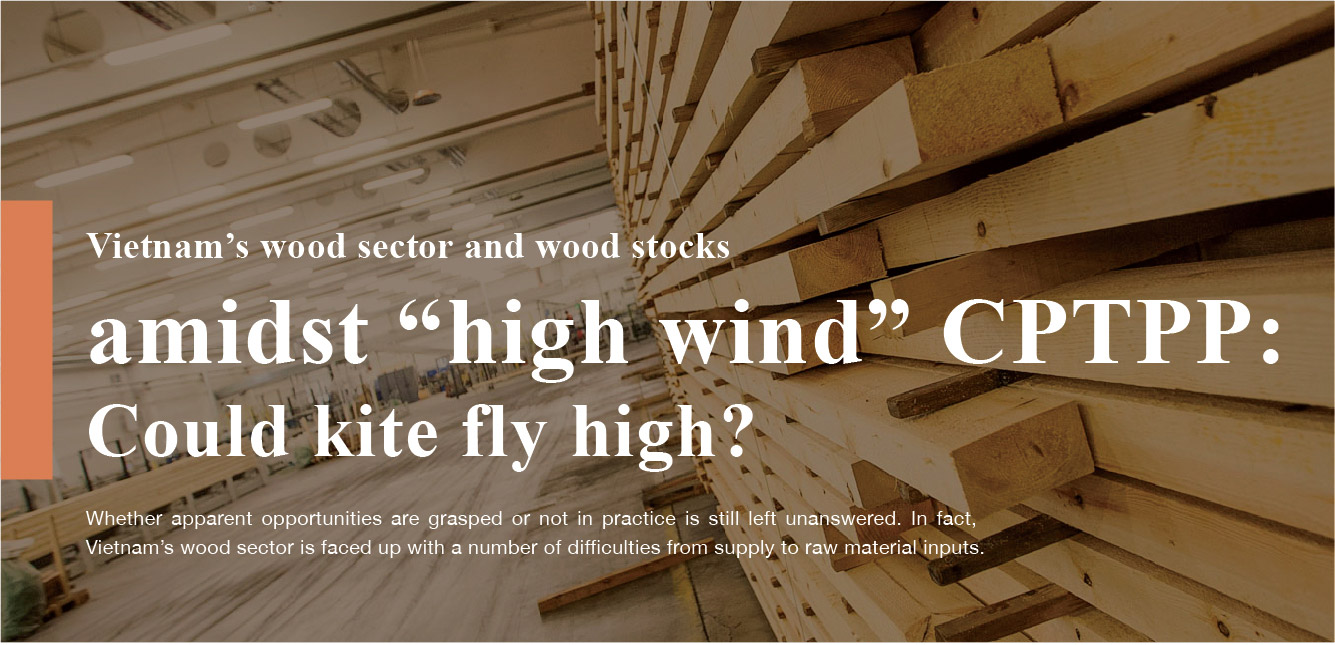
The wood sector, which has recently been on the spot light, is considered to enjoy benefits from free trade agreements, i.e. CPTPP and EVFTA to the most and opportunities from the US-China trade war. The wood sector is expected to break through, and stocks of the sector are receiving special attention in the market.
Whether apparent opportunities are grasped or not in practice is still left unanswered.

CPTPP agreement is set to take effect
Vietnamese wood sector
will enjoy benefits from tariff
CPTPP brings golden opportunities to the wood sector that in Canada market, parquet and bar wood will be no longer subject to tax rate of 3.5% right after the effective date. Other goods products such as handicraft, laminated board, joint board, picture frame, door frame and interiors will be subject to reduced tax rates of 0% from current rate of 6% – 9,5%.
Total wood export turnover amounts to USD 129 million in 2017; USD 131 million for the first ten months of 2018 when the CPTPP agreement is just draft; and is expected to reach USD 140 million for the whole year have demonstrated the significance of Canada market to Vietnam’s wood sector. The growth rate of 8.5% right before “tariff’s opening door threshold” indicates the wood sector has considerable potentials in the Canada market.
Mexico has also agreed to remove import tax on all wood products including laminated board, particle board, wood bar, parquet and interior, exteriors with roadmap of maximum 10 years. Import tax on wood products are currently at relatively high rates from 10 – 15%, which makes Mexico an unanswered market for Vietnamese enterprises.
With regard to EVFTA between EU and Vietnam, the two parties expect to sign in the first quarter of 2019 and submit the Europarl and Vietnam National Assembly for approval. If approval of EVFTA is smooth in the first half of 2019, it would be good news to community of wood manufacturers and exporters in Vietnam as EU is a key market with total export turnover of approximately USD 750m in 2017 and has ample room for growth with Vietnam’s wood products currently accounting for less than 1%.

Apart from tariff, US-China trade war also open up access for Vietnam’s wood sector with increasing import into US market as current import tax rate is 0% whereas China’s is 25% if there is no mutual agreement to end the trade conflict.
Statistics of General Department of Vietnam Customs show that wood export for the first three quarters this year grow steadily, in which US ranks as the leading export country.

Thách thức tiếp đến là phát triển bền vững thế nào khi các thị trường như Hoa Kỳ, Nhật Bản rất quan tâm phát triển rừng. Họ đã đặt ra những yêu cầu rất cao về sử dụng gỗ có nguồn gốc hợp pháp trong ngành chế biến gỗ.
In a recent speech, Deputy Minister of Ministry of Trade and Industry Tran Quoc Khanh stated that it is too soon to consider US-China trade war as a great opportunity for Vietnam’s wood sector. If order movement and investment are made for the sole purpose of tagging wood products as “Made in Vietnam” to avoid import tax to US, Vietnam wood industry will be involved in being imposed tax evasion avoiding tax from US sooner or later.
Admittedly, Vietnamese export to US increases, but China will in turn export to Vietnam. If China export to Vietnam is larger, US will take similar measures sooner or later when Vietnam exports massively to them.
Next challenge is how to develop sustainably in US and Japan market that are interested in developing forestation. They have imposed strict requirements regarding using legal raw materials in wood processing sector.
The wood sector is still facing a number of unresolved issues. Firstly, in terms of supply, selling prices increase while traditionally enterprises are constraint to purchase and hold wood in bulk due to wild fluctuation in prices. Short- contracts in the industry last about 6 months, longer than the fluctuation period, which make unstable supply.
Secondly, in terms of input, Vietnam has yet to have raw material chain which accounts for about 45-50% selling price, so opportunities are theoretical due to not that high productivity.
In practice, average profit margins (applied to all goods) of listed companies are not high. Also, during the first 9 months of this year, profit remains unchanged despite growth in revenue with an exception to Truong Thanh Group – TTG in the middle of restructuring).
Other listed wood company, during the first 9 months this year, Phu Tai (PTB) have accumulated revenues of VND 3,161.4B, up by 9%, and profit of VND 255B, up by 16% over the same period. In which, wood accounts for 38% of revenues and 32% of gross profits, majority of which comes from export to US and EU markets.

And, given unimpressive business performance with a number of unresolved issues, stocks of wood sector are clouded in the market. Thus, whether stocks of wood sector could gain in popularity or not depend on answer to the question “Could wood sector “fly high” amidst opportunities of tariff, open access to markets and benefits from US-China trade war?”.
Average profit margin (applied to all goods) of listed
companies are not high.








Comment